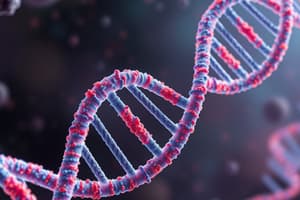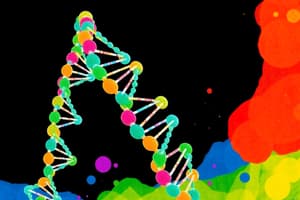Podcast
Questions and Answers
What is the primary purpose of DNA replication?
What is the primary purpose of DNA replication?
- To repair damaged DNA
- To create variations in genetic material
- To duplicate DNA for cell division
- To convert DNA into RNA (correct)
Prokaryotic DNA replication happens in the nucleus of the cell.
Prokaryotic DNA replication happens in the nucleus of the cell.
True (A)
What are the three main steps of eukaryotic DNA replication?
What are the three main steps of eukaryotic DNA replication?
Initiation, elongation, and termination.
During DNA replication, the two strands of the DNA molecule separate and new __________ strands are produced.
During DNA replication, the two strands of the DNA molecule separate and new __________ strands are produced.
Match the following types of DNA replication with their characteristics:
Match the following types of DNA replication with their characteristics:
Which enzyme is responsible for unwinding the DNA during replication?
Which enzyme is responsible for unwinding the DNA during replication?
DNA replication is a conservative process, resulting in two original DNA strands.
DNA replication is a conservative process, resulting in two original DNA strands.
In which direction are nucleotides added during prokaryotic DNA replication?
In which direction are nucleotides added during prokaryotic DNA replication?
What role does DNA helicase play during DNA replication?
What role does DNA helicase play during DNA replication?
Single-strand binding (SSB) proteins are not necessary during DNA replication.
Single-strand binding (SSB) proteins are not necessary during DNA replication.
What are Okazaki fragments?
What are Okazaki fragments?
During DNA replication, __________ proofreads the new strands and corrects any errors.
During DNA replication, __________ proofreads the new strands and corrects any errors.
Match the following terms with their definitions:
Match the following terms with their definitions:
Which of the following statements is true regarding DNA replication in eukaryotes?
Which of the following statements is true regarding DNA replication in eukaryotes?
The leading strand is synthesized discontinuously, while the lagging strand is synthesized continuously.
The leading strand is synthesized discontinuously, while the lagging strand is synthesized continuously.
What is the function of DNA ligase?
What is the function of DNA ligase?
What is the average length of a eukaryotic chromosome?
What is the average length of a eukaryotic chromosome?
Telomerase is necessary for filling the gaps left at the ends of linear chromosomes.
Telomerase is necessary for filling the gaps left at the ends of linear chromosomes.
What is the replication rate of a eukaryotic chromosome?
What is the replication rate of a eukaryotic chromosome?
In prokaryotic replication, the DNA replicates in the ______.
In prokaryotic replication, the DNA replicates in the ______.
Match the terms to their definitions:
Match the terms to their definitions:
How many origins of replication are present in eukaryotic cells?
How many origins of replication are present in eukaryotic cells?
Eukaryotic chromosomes can be shorter after each round of replication due to incomplete replication at the ends.
Eukaryotic chromosomes can be shorter after each round of replication due to incomplete replication at the ends.
What are the major differences between prokaryotic and eukaryotic replication regarding the speed and number of DNA polymerases involved?
What are the major differences between prokaryotic and eukaryotic replication regarding the speed and number of DNA polymerases involved?
Flashcards are hidden until you start studying
Study Notes
DNA Replication
- DNA replication is the process of creating two identical copies of a DNA molecule
- DNA replication occurs before cell division to ensure each daughter cell receives a complete set of DNA
- Both prokaryotes and eukaryotes replicate DNA semi-conservatively, meaning each new DNA molecule contains one original strand and one newly synthesized strand
Prokaryotic and Eukaryotic Differences
- Prokaryotic DNA is circular and located in the cytoplasm
- Eukaryotic DNA is linear and located in the nucleus
- Prokaryotes have a single origin of replication, while eukaryotes initiate replication at multiple origins
DNA Replication Steps
- DNA replication occurs in three steps: initiation, elongation, and termination
- The process starts with the unwinding of the DNA double helix, which is carried out by the enzyme helicase
- Single-strand binding proteins (SSBs) stabilize the separated strands, preventing them from re-annealing
- DNA polymerase adds nucleotides to the newly synthesized strand, following the base pairing rules (A with T, and G with C)
- DNA polymerase I proofreads the newly synthesized strands, correcting any errors
- DNA ligase joins the newly synthesized fragments together
Leading and Lagging Strands
- Replication occurs in both directions from the origin, creating two replication forks
- One strand, the leading strand, is synthesized continuously in the 5’ to 3’ direction
- The other strand, the lagging strand, is synthesized discontinuously in short fragments called Okazaki fragments
Telomeres
- Telomeres are repetitive sequences at the ends of linear eukaryotic chromosomes
- Telomerase, an enzyme with an RNA component, adds these repeated sequences, preventing chromosome shortening during replication
Prokaryotic vs. Eukaryotic Replication
- Prokaryotic replication occurs in the cytoplasm, while eukaryotic replication occurs in the nucleus
- Prokaryotic replication is faster than eukaryotic replication
- Prokaryotic DNA is circular, while eukaryotic DNA is linear
- Prokaryotes use DNA polymerase I and III, while eukaryotes use DNA polymerase α, δ, and ε
Replication of Circular DNA
- In some prokaryotes, replication begins at a single origin and continues in two directions until the entire chromosome is copied
- The resulting structure looks like the Greek letter theta (θ)
Rolling Circle Model
- This model is common in bacteriophages and uses a nick at the origin of replication to initiate DNA synthesis
- The 5' end of the molecule is displaced and acts as a primer, allowing for continuous replication and multiple copies of the genome
Eukaryotic Chromosome Replication
- Eukaryotes replicate their chromosomes during the S phase of the cell cycle
- The process requires multiple origins of replication to ensure efficient replication of the large eukaryotic genome
Checkpoints in Eukaryotic Replication
- Several checkpoints ensure proper DNA replication before cell division
- These checkpoints include proteins called cyclins and enzymes called cyclin-dependent kinases (Cdks)
- These ensure the cell is large enough, the environment is favorable, all DNA is replicated, and chromosomes are attached to the mitotic spindle
Nucleosome Assembly
- During replication, nucleosomes must disassemble and reassemble
- New histones and associated chromatin proteins must be synthesized for the newly formed DNA molecules
Studying That Suits You
Use AI to generate personalized quizzes and flashcards to suit your learning preferences.




